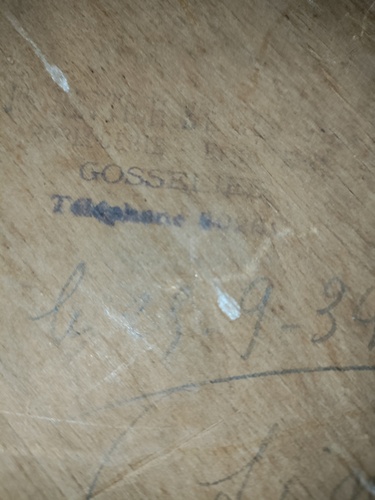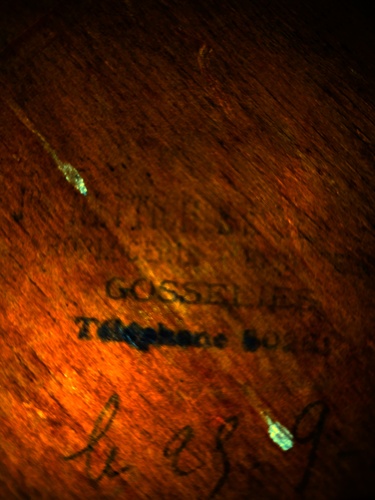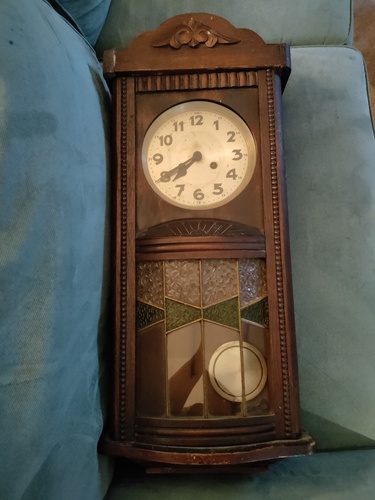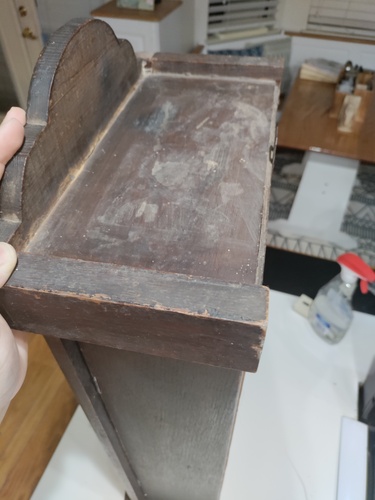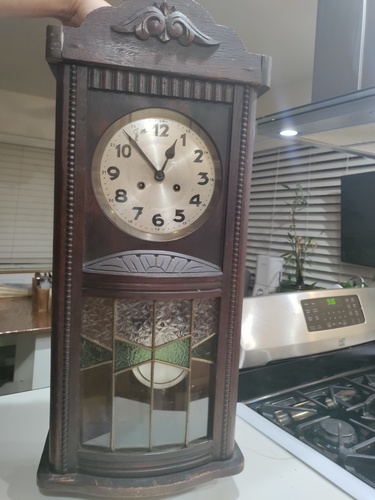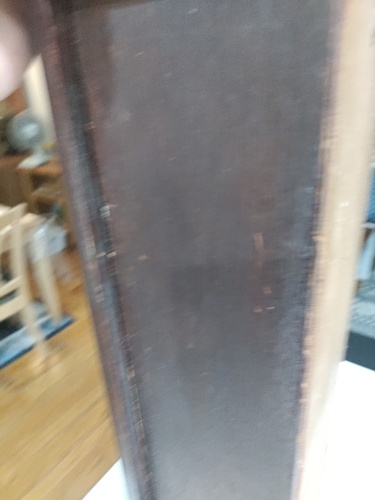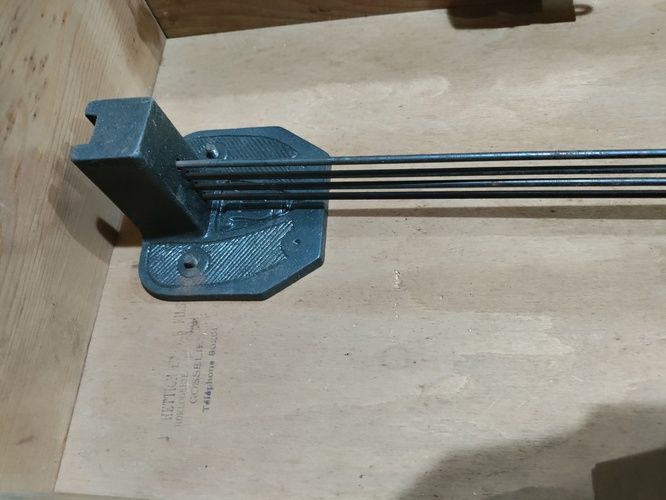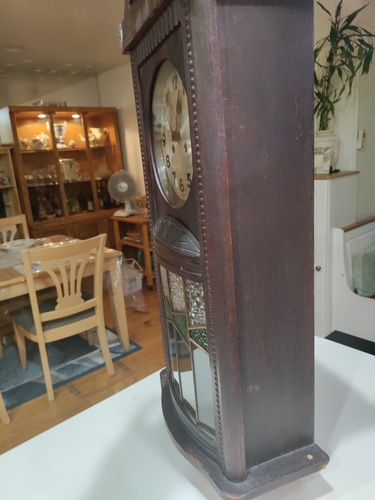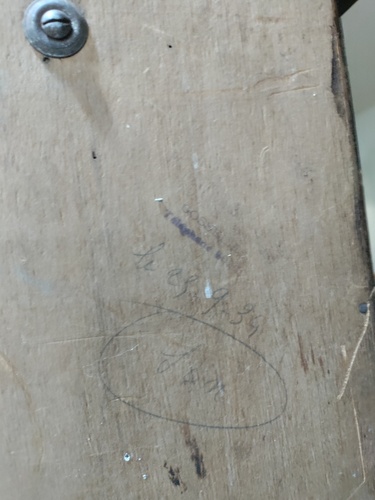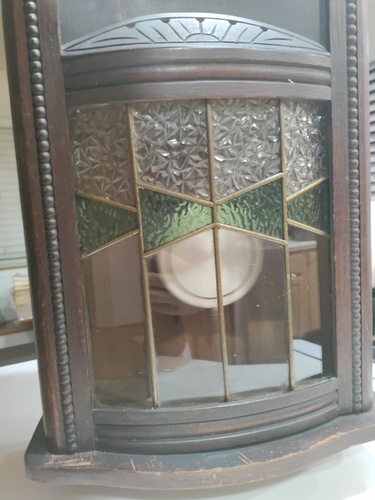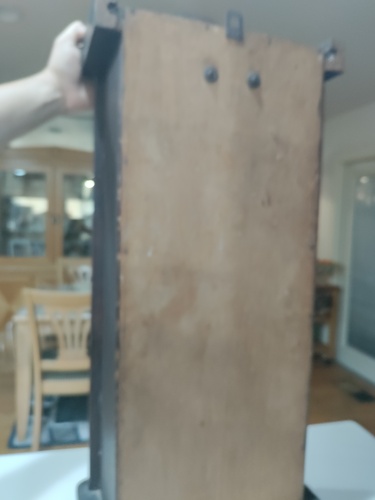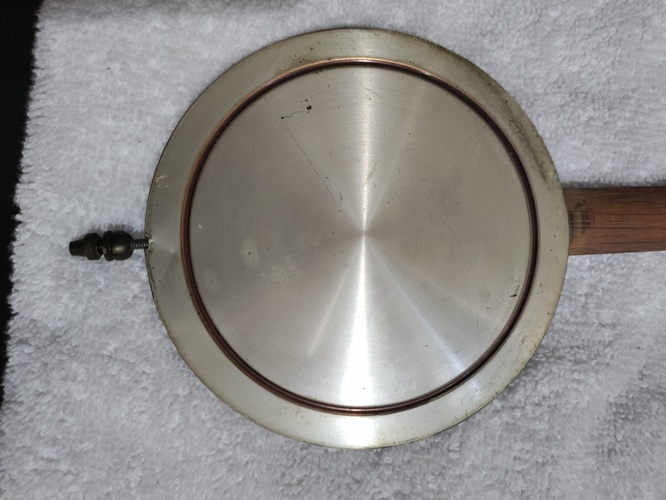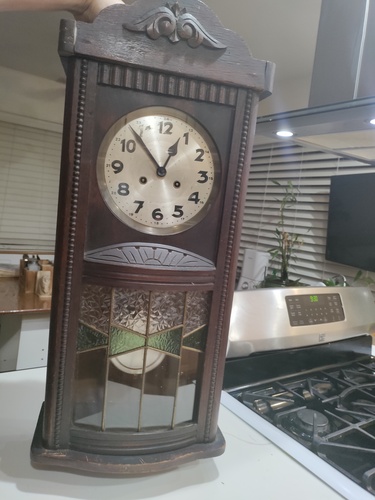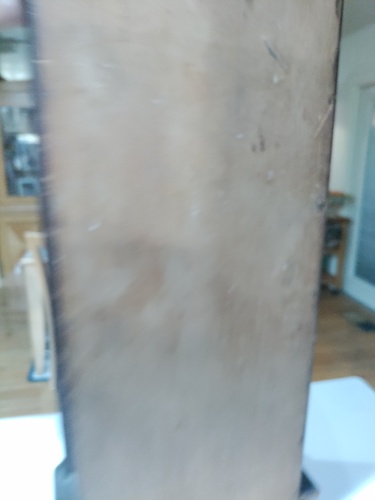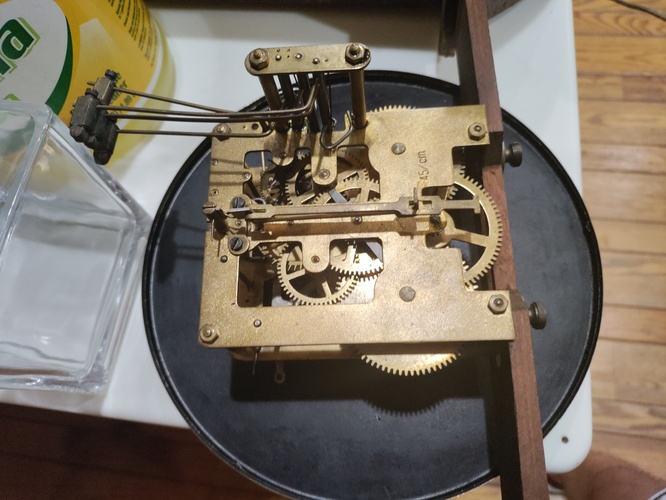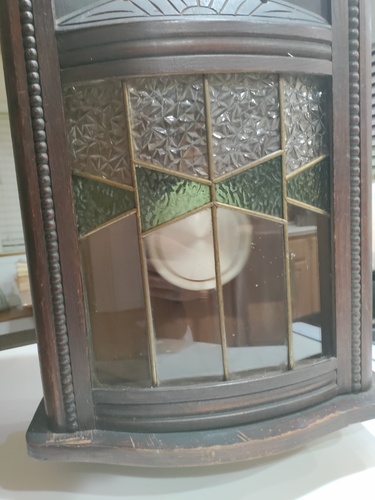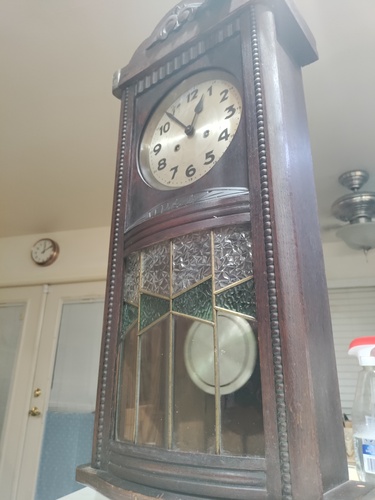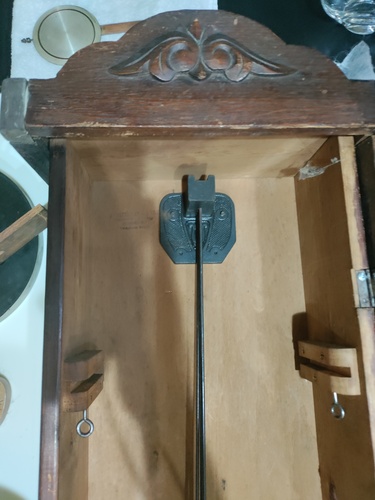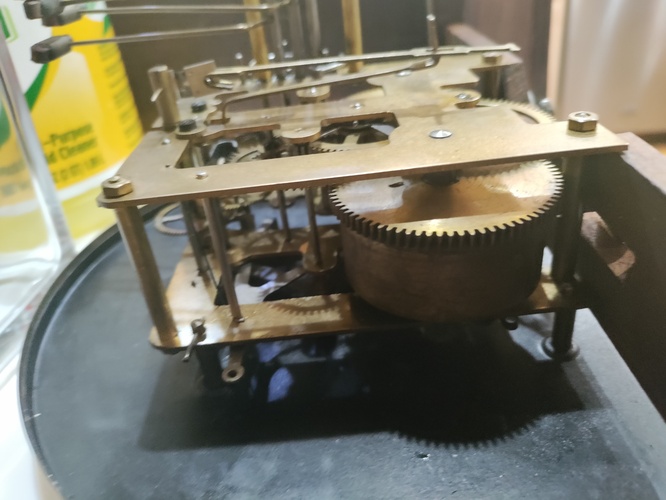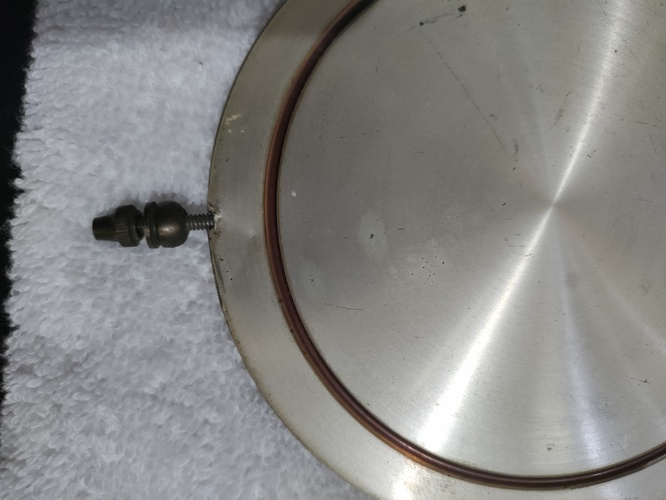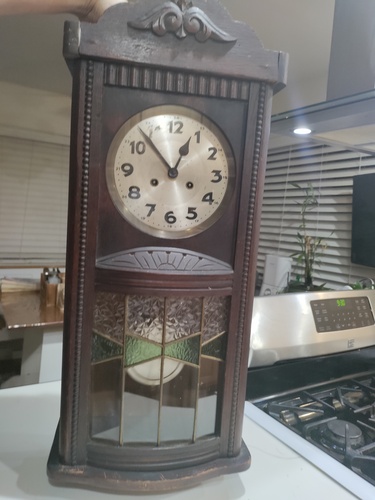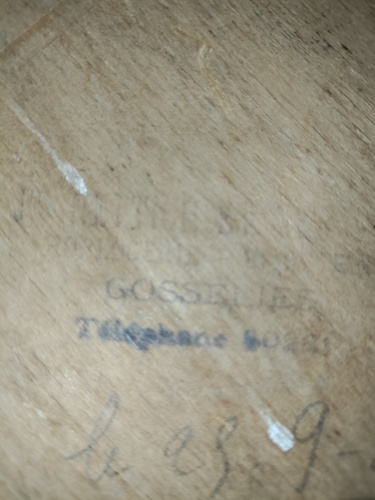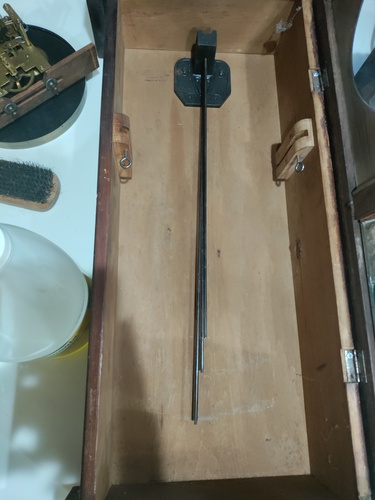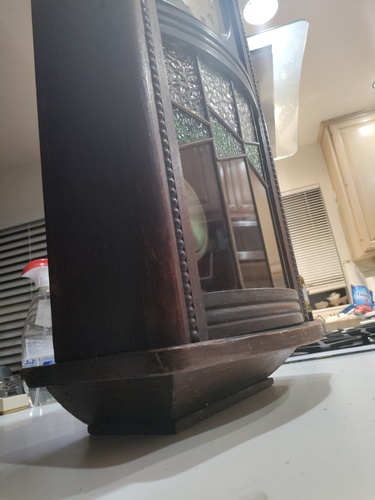Colored glass with pendulum behind it and winding key.
Father has passed on.


Hello Matthew,
Thank you for sending in this interesting wall clock to mearto.com for an appraisal. Here is what you requested.
TITLE:
Art Deco, walnut-stained oak, two train, spring driven, eight-day time and chiming, “Box” wall clock with 24 hour dial, retailed by J. Hettich & Sons Horlogerie, Gosselies, Belgium, clock made in Germany, unsigned but attributed to Friederick Mauthe (maker of the Lyragong), Schwenningen Germany, and made circa 1935-1939.
PROVENANCE:
Father has passed on AND I INHERITED THIS CLOCK.
DESCRITPTION
Case: Size not provided but approximated at 36-inch x 24-inch x 20-inch, walnut stained oak, ‘box’ wall clock. This is an essentially rectangular wooden wall clock, hence the name ‘box clock’. This example has a tripartite convex solid fretwork between the rounded corner posts with an applied pinwheel foliate carved wooden design. There is a horizontal cornice at the base of the fret which sits over the door on the façade, the latter divided into two major parts. The upper half of the dial door is flat and rectilinear while centering the round silvered dial. Above the dial is a row of dentil moulding, flanked on both sides by vertical pilasters with beading and below with a thick bowed out cornice with incised sunrays. The bowing or bombe shape continues in the horizontally fluted wooden sections which transition down to the lower half. The lower half of the dial door is made up of glazed panels frosted crystals of glass above lime green section over the panels using translucent glass. The sections are divided by white metal tubular fretwork, perhaps aluminum. At the bottom of the door the bombe horizontally fluted wooden sections are repeated. The base moulding is concentric with the shape of the lower half of the door. The stamps and written words appear to be on the outside of the backboard, and from what can be made out reads, “J. Hettich and Fils (sons), Horlogerie (clockmakers), Gosselies (a town in Belgium near the German border where Furtwangen is located, so near the Black Forest region), ‘Telephone 50261’.
Dial: A round silvered metal dial with polished tin or zinc bezel. There are enameled black Arabic hours (1-12), open dotted minute track with Arabic second hour chapter ring (13-24) placed every five minutes. (Such 24 hour dials are usually found on clocks made in close proximity to wartime and this was in the early stages of World War II. There are two spring winding arbors and steel Continental type spade hands. The dial is unsigned.
Movement: The dial and movement are attached and sit on a seatboard which slides into a groove in the seat built within the case and is secured with metal thumb screws.
This is a solid brass plate movement connected by tubular pillars connecting the front and rear plates and are secured with screws and nuts at the back plate. Two steel barrel springs power the movement for eight days and cause striking on a set of four metal rods of varying length by a set of four movement hammers. This from of chiming most likely occurs on the quarter hours with a full strike and chime on the hours. Of not is the black base of the gong which is attached to the upper backboard. Although it bears no names, as earlier German gongs did, there is a symbol of a lyre, the musical instrument that resemble the early harp. There was a type of gong that did carry the shape of the harp but was accompanied by the initials F and M. I believe that Frederick Mauthe, the German clockmaker may have made the “lyragong, as well as the movement. The other German characteristics of this movement is the screwed down eyeglass-shaped pendulum suspension bridge from which the pendulum rod hangs. In addition, the manner in which the four movement hammers stand proud of the movement is another German feature. The only other marking on the movement is 345 cm, the length of the pendulum rod. The rod with white metal volute type bob swings in the case below.
Condition: Case – Some flaking of the finish on the pediment fretwork and some wear to the finish around the base, but otherwise is in very nice condition. An especially pleasing design for such a simple box clock.
Dial – Good with few smudges and wear to the numerals especially at the top of the dial.
Movement – appears to be original to this case, genuine and functional.
COMPARABLES: \
Since comparables in this style are very difficult to locate, I will tell you that box wall clocks, both German and English generally will sell, in good condition for $150-$200
SEE: ~https://www.liveauctioneers.com/item/88799162_nice-antique-german-box-clock (Sold for $150 in 2020)
~https://www.barnebys.com/realized-prices/lot/three-antique-european-wall-clocks-1-french-pic-P6s14AW6eV (German box clock sold with two other clocks, French picture frame and Scottish wall, all three for $375 in 2019)
~https://www.barnebys.com/realized-prices/lot/german-wall-clock-OcE1TYjae (Made by Mauthe with Viola gong (coiled) and resembling your case. It sold in 2013 for $299)
~https://www.liveauctioneers.com/item/23622102_german-art-deco-hanging-box-clock (Sold for $300 in 2014)
~https://www.liveauctioneers.com/item/93892284_antique-oak-german-wall-box-clock (Sold for $50 in 2020)
HISTORY:
MAUTHE CLOCK COMPANY
Friedrich Mauthe (1822-1884) began work as a supplier of parts for clockmakers in Schwenningen Germany. It was not until 1860 that he started manufacturing clocks on his own. In 1876 his sons, Christian and Jacob, joined the firm which became the Mauthe Clock Company (Mauthe Uhrenfabrik). In 1899 they added their own case factory and employed 1000 workers. By 1930, 2000 employees produced 45,000 clocks per week. In 1937 60% of the clocks imported into England were made by Mauthe. This clock company survived the war and did not close its doors until 1976. I could find no less than 30 trademarks filed by this Germany clockmaking company. (One of these trademarks is ADLER OR ADLERGONG, which they registered in January of 1930.) They did use five similar but slightly different trademarks that used the wings of an eagle and ‘FM’. And they were filed with the German government in the years, 1923, 1925, 1925, 1936 and 1936.
PRICING:
I think if you offered your clock for sale in today’s demanding market place it would have a fair market value in the $275-$325 range. Retail pricing would be about twice that amount. Thank you again for choosing mearto.com for your appraisal.
My best,
David
Please log in to your Mearto account to contact this seller or make an offer on this item.
